ALOE VERA AND ITS USES
September 20, 2012 by admin
Filed under Tips for Ayurveda
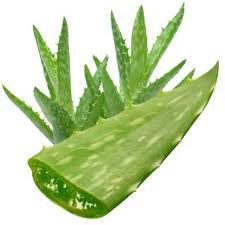 Aloe vera is a species of succulent plant that probably originated in northern Africa. The species does not have any naturally occurring populations, although closely related aloes do occur in northern Africa.
Aloe vera is a species of succulent plant that probably originated in northern Africa. The species does not have any naturally occurring populations, although closely related aloes do occur in northern Africa.
Aloe Vera is a medicinal plant which belongs to the family of Cactus. There are several varieties of this plant but only one particular variety is used for medicinal purposes. The medicinal reputation of Aloe Vera dates back to many thousand years.
The Latin word Vera meaning ”True” was added to this particular species of Aloe plant to distinguish it from the rest of the aloe plants. Only this particular species has the therapeutic properties. The medicinal properties of the Aloe Vera plant have been re-discovered recently. But it is one of the age old natural remedies used by our ancestors. . It has vitamins, sugars, minerals, anthraquinones and many more. It has an enzyme called carboxy-peptidase that has anti-inflammatory effects. It also has various amino acids, Vitamins A, C and F .Aloe Vera is a truly magical herb.
The Use of Aloe Vera is found in Ayurveda in various text books, post Samhita period. It is a perfect plant for your home. A common sight in India, aloe vera plant is placed in pots or hung in pots at the entrance of houses.
Health Benefits of Aloe Vera
- Any kind of wound is healed either by topical dressing or by oral intake. Aloe Vera heals scalds, burns and speeds up the healing and recovery period as well. It is a natural coolant.
- Aloe Vera is a powerful detoxifier, antiseptic and tonic for the nervous system.
- Aloe Vera also has immune-boosting and anti-viral properties.
- Aloe Vera improves digestion. As a general health tonic, there are benefits in taking a measure of Aloe Vera each day.
- Aloe Vera is used as a tonic to treat amenorrhea, jaundice and piles.
- The acid found inside Aloe Vera is used as an effective pain killer.
- Aloe Vera is beneficial for the skin, prevents acne, and enhances skin growth.
- Aloe Vera is used to treat dermatitis, disorders of the skin and X-ray burns.
- Aloe Vera has a great ability to heal burns, ulcers and wounds.
- Aloe Vera is also used as an antiseptic that kills bacteria, fungi, molds and viruses.
- Aloe Vera can be used for insect bites, sores, urticaria, blisters, herpes, athlete’s foot, vaginal infections, allergic reactions, conjunctivitis, dry skin and fungal infections.
- Other benefits are the topical application of this herb helps in curing frostbite, psoriasis, rosacea, wrinkles, aging, warts and eczema.
- Oral intake of Aloe Vera is effective in treating and soothing heartburn, rheumatic pain, asthma and arthritis.
- Aloe Vera has positive effect in lowering the blood sugar levels in Diabetes Mellitus.
- Aloe Vera supports as a laxative. Prevents constipation.
- Aloe vera is a good anti-aging herb. It is extensively used in preparation of cosmetics products. Aloe vera is also known to help slow down the appearance of wrinkles. It is an excellent moisturizer.
- Aloe Vera is a plant with a rare ability to calm all the three Doshas.
- Aloe Vera is believed to reduce severe joint and muscle pain associated with arthritis, as well as pain related to injuries. Direct application on the affected area is recommended.
- Aloe Vera heals skin problems like psoriasis.
- Enzymes present in aloe vera helps in strengthening hair. Aloe vera is also found useful for treating androgenic alopeda.
- Too long use of this herb can result in hematuria, loss of potassium, albuminaria and imbalance of fluids in the human body.
- The oral intake can result in diarrhea and abdominal cramps.
- Aloe vera is found to cause rashes in some skin, when used externally. So please use this plant products only after consulting your physician.
- It should not be used during menstruation, Pregnancy, breast feeding and intestinal disorders.
Few watch outs during usage of Aloe vera:
- Too long use of this herb can result in hematuria, loss of potassium, albuminaria and imbalance of fluids in the human body.
- The oral intake can result in diarrhea and abdominal cramps.
- Aloe vera is found to cause rashes in some skin, when used externally. So please use this plant products only after consulting your physician.
- It should not be used during menstruation, Pregnancy, breast feeding and intestinal disorders.
HONEY AND ITS USES
September 20, 2012 by admin
Filed under Tips for Ayurveda
What is honey?
Honey is a sweet, dense sugary compound made by bees. This compound of honey consists of properties in varying proportions of glucose, water, fructose, oil and unique enzymes produced by bees. The initial step in building honey begin when field bees fly from flower to flower gathering the sweet fluids or nectar that is available in a flower. The field bees suck out the nectar with their tongues and store it in bags enclosed by their bodies. After filling their bags with these sweet juices, the field bees fly back to their bee hive and empty the stored nectar into the mouths of house bees.
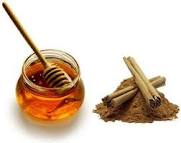 These house bees are apportioned the job of adding on enzymes from their bodies to the nectar. The enzymes functions which cause the water in the nectar to evaporate-thereby transforming the nectar into honey. Finally, the nectar is stored in a cell of a honeycomb. Overtime, the nectar develops and becomes honey.
These house bees are apportioned the job of adding on enzymes from their bodies to the nectar. The enzymes functions which cause the water in the nectar to evaporate-thereby transforming the nectar into honey. Finally, the nectar is stored in a cell of a honeycomb. Overtime, the nectar develops and becomes honey.
Honey has been in use for the benefit of human beings since as long as 2500 years and that too all across the globe. The qualities of honey are mentioned in the Ayurvedic text-book of Sushruta Samhita.
Honey in its raw form is pure and doesn’t require any kind of additional flavors. It is one of the best sources of energy. Honey when consumed with different natural products such as milk, fruit juices and others can really help in treating various diseases which include asthma, cough and many more. Listed below are some of the ayurvedic benefits of honey.
Ayurvedic benefits of honey
In weight loss: Honey when mixed with warm water and consumed can prove beneficial for people who want to lose weight. In the same manner, honey when consumed with lemon juice with cinnamon also contributes heavily towards weight loss.
In reducing cough: Honey when mixed with ginger juice provides immediate relief from cough and cold and opens the congestion in the chest. It also cures sore throat. Honey helps decrease nighttime coughing and enhances better sleep.
In controlling high Blood Pressure: One tsp of honey when consumed with one tsp ginger juice every morning and in the evening can really bring down high blood pressure.
In reducing Cholesterol: Make a paste of honey with cinnamon powder, you can eat it regularly by spreading it on bread or chapatti instead of jelly and jam. This combination of honey can help to reduce the cholesterol in the arteries. It may be also lower the possibility of a heart patient suffering from a heart attack
For Arthritis treatment: Massage the paste of honey with lukewarm water in a ratio of 1:2 and add ½ teaspoon of cinnamon powder. slowly onto the painful region of the body. It has been found that the pain had a decrease within half an hour or two. Patients can daily intake honey in the following ratio and find relief.1 cup of water and 2 tspns of honey or mix honey and cinnamom powder and consume it.
As a heart tonic: Honey can also be used as a very good tonic for the heart. This is because it nourishes the heart muscles and enhances their functions thereby resulting in overall well being of the body.
In curing asthma: A mixture made up of ginger juice, black pepper powder and honey when taken at least three times a day can really help prevent asthma attacks and cure asthma.
In improving eyesight: Carrot juice when taken with honey can really help to improve the eyesight. Take this mixture one hour before having your lunch.
In boosting immune system: Daily use of honey and cinnamon powder strengthens the immune system and guards the body from germs and viral attacks. Daily use of honey strengthens the white blood atoms to fight against bacteria and viral diseases.
In reducing fatigue: Honey have primarily properties of fructose and glucose, as a result a result it’s quickly absorbed by the digestive system. Honey is a unique and natural stabilizer .Take honey with cinnamon powder in equal quantities.
Benefits of honey:
- source of vitamins and minerals, source of energy
- healing of wounds especially burns. Heals faster
- reduction of fat
- blood purification
- improves skin complexion and moisturizes skin
- good antiseptic: can be applied directly on scars and pimples.
- improves appetite
GARLIC AND ITS USES
September 20, 2012 by admin
Filed under Tips for Ayurveda
Allium sativum, commonly known as garlic, is a species in the onion genus, Allium. Its close relatives include the onion, shallot, leek, chive and rakkyo.
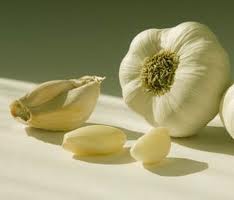 Raw garlic is one of the very ancient spices used in Ayurveda. Even Sushruta has appreciated the benefits of raw garlic and is quoted in his writings. Sweet, salt, sour, pungent, bitter and astringent are the six tastes according to Ayurveda beliefs. Garlic is one of those rare herbs which has five tastes except sour.
Raw garlic is one of the very ancient spices used in Ayurveda. Even Sushruta has appreciated the benefits of raw garlic and is quoted in his writings. Sweet, salt, sour, pungent, bitter and astringent are the six tastes according to Ayurveda beliefs. Garlic is one of those rare herbs which has five tastes except sour.
Nature has gifted us lots of things to keep our self healthy. One of those gifts is Garlic. This great bulb has a lot of benefits, because no other plant has been held out for so long as a cure for so many human ailments. That’s why garlic has been considered as the “Wonder Drug”. Garlic has been used medicinally for many years for treating bites, tumors, ulcers, snakebite, wounds, headaches, heart diseases, cancer, pimples, measles and many more. It also prevents infections such as the common cold, cough because of its Anti-bacterial, Anti-fungal and Anti-viral property.
A famous proverb: ” Garlic is as good as 10 mothers “ , “Garlic a day keep sickness at bay” and ” A garlic a day keeps diseases away”. Moreover, it is regarded as a miracle by naturopaths & herbalists. Various researches have proved it that Garlic is good for health and is beneficial in curing various health problems.
The garlic clove contains various nutrients as water soluble nutrients include vitamins, enzymes, amino acids and natural sugars & oil soluble nutrients includes sulphur compounds originating from an amino acid named alliin which is converted to a pungent compound called allicin which has natural antibiotic properties. Presence of sulphur in garlic is the cause of its pungent smell. However, the quality of Garlic cannot be over hidden due to this smell.
Garlic Medicinal Uses
- Garlic acts as an antiseptic & helps in curing the wounds very quickly.
- One of the health benefits of garlic is that it helps in fighting against various infection & acts against inflammation and infection, including colds and flu, coughs by adding a freshly cut raw clove to food three times a day.
- In certain studies in China it has been shown that it contains chemicals that prevent cancer. They suggest that eating garlic on regular basis provides some protection against cancer.
- Fresh or cooked garlic helps in lowers down the blood pressure and cardiovascular problems. It increases the levels of high density lipoproteins and reduces harmful cholesterol in the blood & keeps arteries and heart healthy.
- It thins the blood, reduces clotting and helps in controlling blood pressure and poor circulation.
- Garlic stimulates the immune system of body and helps in fighting against various diseases.
- Use two raw garlic daily to reduce the risk of cancer, due to its Anti-Carcinogenic properties. It helps prevent cancerous compounds from forming and developing into tumors. It also inhibits the growth of tumors.
- Prevents and relieves chronic bronchitis, respiratory problems, and mucous formation.
- It acts as a nasal decongestant and expectorant.
- Garlic works as a cleanser of the digestive system, helps in curing gastric formation, kills internal parasites and is an excellent internal antiseptic.
- It exhibits antioxidant activity, which is good for your skin. It also contains flavonoids, which is good for heart and body.
- Garlic cures Earache, put two or three drops of warm garlic oil in the ears.
- Garlic is a natural aphrodisiac, it stimulates sexual desire. Normally not consumed by people in celibacy, who have taken vows not to marry.
- If any insect bites you at the seaside, you just crush the garlic and apply it to the affected area to reduce pain and to remove poison.
- If you are very fat and want to loose weight, squeeze half lemon juice in one glass of luke warm water and drink it with two cloves of raw garlic regularly twice a day (morning and evening), for about three months. Avoid using starchy foods and fats. Do exercise regularly. You will observe a great change in your body.
- Garlic supports anti-ageing . Use 2-3 cloves regularly for better results
Researcher recommends daily dose of fresh garlic of about 4 gm, equivalent to one or two small cloves for each & every person who wants to keep himself healthy.
Few watch outs for the usage of garlic:
- Garlic may cause or worsen bad breath problem.
- It is advised not to take garlic soon after heavy exercise or when someone has just come from sunlight.
- Since Garlic is hot and pungent, it should not be taken when someone has nasal bleeding and dizziness.
- For women suffering from heavy menstrual bleeding, it is advisable to stop using garlic from 5 days before onset of periods till it stops.
TURMERIC AND ITS USES
September 20, 2012 by admin
Filed under Tips for Ayurveda
Ayurveda is a holistic system of medicine that is indigenious to and widely practiced in India.The word Ayurveda is a Sanskrit term meaning “science of life”. AYU means “life” and VEDA is “book of knowledge”. Ayurveda was first recorded in the Vedas, the world’s oldest existing literature. This healing system has been practiced in daily life in India for more than 5,000 years. Ayurveda is the science of life which balance us in being healthy.
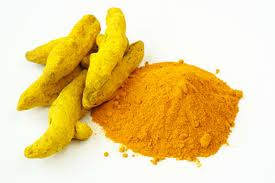 Turmeric (Curcuma longa) is a rhizomatous herbaceous perennial plant of the ginger family, Zingiberaceae. It is native to tropical South Asia . Although turmeric has long been appreciated for its culinary and medicinal value in India, it is only recently that western scientists have recognized this ancient spice for more than just its organoleptic qualities.
Turmeric (Curcuma longa) is a rhizomatous herbaceous perennial plant of the ginger family, Zingiberaceae. It is native to tropical South Asia . Although turmeric has long been appreciated for its culinary and medicinal value in India, it is only recently that western scientists have recognized this ancient spice for more than just its organoleptic qualities.
In India turmeric is very auspicious and considered to give the energy of the divine mother and grants prosperity. Since ages turmeric was valued for its medicinal properties and extensively used due to its availability. It is popularly used as a dye.
The benefits of turmeric:
- Turmeric is an excellent natural antibiotic while at the same time it strengthens digestion and helps improve intestinal flora.
- It is a good anti-bacterial for those chronically weak or ill.
- It not only purifies the blood, but also warms it and stimulates formation of new blood tissue.
- It is effective for cleansing the chakras (nadi-shodhana), purifying the channels of the subtle body.
- It helps stretch the ligaments and is, therefore, good for the practice of yoga.
- Turmeric promotes proper metabolism in the body, correcting both excesses and deficiencies. It aids in the digestion of protein.
- Externally, it can be used with honey for sprains, strains, bruise or itch. It is tonic to the skin, for which purpose it can be taken internally as a milk decoction.
- Turmeric is aromatic and a stimulant and has many helpful functions. It is bitter, slightly pungent and a good blood purifier, and works as a tonic to aid digestion and relieve congestion.
- It has a soothing action on respiratory ailments such as cough and asthma.
- It also is anti-arthritic and acts as a natural anti-bacterial.
- Turmeric may be added to high-protein food to assist digestion and prevent the formation of gas. It is effectively used to maintain the flora of the large intestine.
- It is used to treat obesity and high cholesterol and to stimulate digestion.
- It aids in the digestion of protein.
- Externally, it can be used with honey for sprains, strains, bruise or itch.
- It is tonic to the skin, for which purpose it can be taken internally as a milk.
Turmeric contains a variety of bioactive substances called curcuminoids. The most active component is curcumin, an orange-yellow volatile oil. Curcuminoids have a number of beneficial properties:
1) good antioxidant activity, comparing well with vitamin C, vitamin E and superoxide dismutase;
2) anti-inflammatory activity that is comparable to steroidal and nonsteroidal drugs
3) anticancer properties influencing all the steps of cancer formation: initiation, promotion, and progression
4) protects the cardiovascular system by lowering serum cholesterol and inhibiting platelet aggregation;
5) protects the liver by several mechanisms;
6) in vitro and in vivo studies show curcuminoids can help with HIV in a number of ways, including acting as biological response modifiers
In most homes India, the Friday oil bath routines with the application of Haldi is almost sacrosanct with the South Indian women, resulting in beautiful skin, and hairless bodies! In fact, in South India, it is considered very auspicious and therefore, is the first item on the grocery list.
In many North and South Indian traditional wedding ceremonies, haldi is applied to both, the groom and the bride, not only to make them look good with fresh glowing skins, but to ward off the evil eye. It is considered by the Hindus as a symbol of prosperity and as a cleansing herb for the whole body.
During ceremonies., pieces of crushed roots mixed with seawater are sprinkled to remove the negative influences from places, persons and things.
The healing properties of turmeric have made it a most sought after ingredient in cosmetics and drugs, as the leaf oil and extract can also be used as sunscreens and bio-pesticides.
TULSI ( HOLY BASIL) AND ITS USES
September 20, 2012 by admin
Filed under Tips for Ayurveda
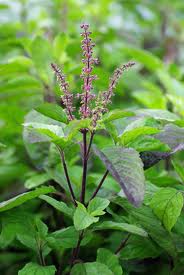 Ocimum tenuiflorum, Holy Basil( Tulsi), is an aromatic plant in the family Lamiaceae which is native throughout the Old World tropics and widespread as a cultivated plant and an escaped weed.
Ocimum tenuiflorum, Holy Basil( Tulsi), is an aromatic plant in the family Lamiaceae which is native throughout the Old World tropics and widespread as a cultivated plant and an escaped weed.
The tulsi or holy basil is an important symbol in the Hindu religious tradition and is worshipped in the morning and evening by Hindus at large. The holy basil is also a herbal remedy for a lot of common ailments. It is considered as India’s Queen of herbs. They are largely used in ayurvedic medicines. It has got medicinal properties as well as cosmetic properties. Tulsi is grown in almost all Indian homes.
Tulsi’s main Ayurvedic quality as a healing herb is its ability to enhance the energetic resonance between the body and the environment. Tulsi helps to decrease Kapha. The channels open, ama is cleared out of the body and the body’s agni–the fire element in the physiology–becomes strong again. Balance is restored among the three doshas, and the immune system is restored to a healthy state. The qualities of Tulsi is mentioned in Charaka Samhita.
The varieties of tulsi are Krishna Tulsi, Rama Tulsi and Vana Tulsi. Of the three varieties Krishna tulsi & Rama Tulsi are widely used in ayurvedic medications.
The uses of tulsi are:
- The tulsi plant has many medicinal properties. The leaves are a nerve tonic and also sharpen memory. They promote the removal of the mucous matter and phlegm from the bronchial tube. The leaves strengthen the stomach and induce profuse sweating
- During cold and fever the tulsi leaves can be boiled with tea, it acts as a prevention against malaria and dengue. If the fever is high , prepare a decoction of the leaves with powdered cardamom in half 2 glasses of water , mix this to sugar and milk. This preparation will bring down the temperature.
- When children are having fever, tulsi leaves helps in bringing down temperature. Crush tulsi leaves and collect 2 to 3 spoons of tulsi juice, mix this to 1 cup of water. Keep feeding the child with 4-5 tspns in regular intervals. This is very effective in bringing down the temperature.
- Tulsi leaves is a basic ingredient for many Ayurvedic cough syrups and expectorants. It helps to mobilize mucus in bronchitis and asthma. Chewing tulsi leaves relieves cold and flu.
- Tulsi is used in the treatment of respiratory system disorder. A decoction of the leaves, with honey and ginger is an effective remedy for bronchitis, asthma, influenza ( flu), cough and cold. They should be boiled in 2 cups of water till only half the water is left . This can be consumed when luke warm. Add little salt or sugar to enrich taste.
- Tulsi relieves sore throat. Boil water with tulsi leaves, when luke warm the mixture can be consumed. This can be used to gargle mouth also. The leaves are quite effective for the ulcer and infections in the mouth. Chewing a few leaves will cure these conditions.
- Tulsi leaves has strengthening effect on the kidney. In case of Kidney stone , if the juice of tulsi leaves mixed with honey is taken for 6 months, it will expel the stone via the urinary tract.
- Tulsi is highly beneficial for patients with heart problems and the weakness resulting from them. It reduces the level of blood cholesterol. Tulsi leaf when eaten in the morning purifies blood.
- Tulsi leaves juice and ginger juice cures stomach ache, cramps and also gets relief from stomach worms.
- Basil makes a good medicine for headache. A decoction of the leaves can be given for this disorder. Pounded leaves mixed with sandalwood paste can also be applied on the forehead for getting relief from heat, headache and for providing coolness in general.
- Tulsi juice is an effective remedy for sore eyes and night-blindness, which is generally caused by deficiency of vitamin A. Two drops of black tulsi juice are put into the eyes daily at bedtime.
- Applied locally, basil juice is beneficial in the treatment of ringworm and other skin diseases. It has also been tried successfully by some naturopaths in the treatment of leucoderma. It helps in controlling dandruff. Tulsi can be used by mixing with coconut oil.
- The herb is a protective, preventive and curative for insect stings or bites. A teaspoonful of the juice of the leaves is taken and is repeated after a few hours. Fresh juice must also be applied to the affected parts. A paste of fresh roots is also effective in case of bites of insects and leeches.
- Common pediatric problems like cough cold, fever, diarrhea and vomiting respond quickly to the juice of basil leaves. It is very effective in restoring heath during conditions like convulsions and cholera.
- The herb is useful in teeth disorders. Its leaves, dried in the sun and powdered, can be used for brushing teeth. It can also be mixed with mustard oil to make a paste and used as toothpaste. This is very good for maintaining dental health, counteracting bad breath and for massaging the gums.
- Tulsi leaves are regarded as an ‘adaptogen’ or anti-stress agent. Leaves provide significant protection against stress. Even healthy persons can chew 10 to 12 leaves of basil, twice a day, to prevent stress. It purifies blood and helps prevent several common elements.
- The leaves are very effective for the ulcer and infections that develop in the mouth. A few leaves chewed will cure these conditions.
- The stems are dried and made as garland beads, considered very holy.
HOW TO PREVENT ACNE
September 20, 2012 by admin
Filed under Tips for Ayurveda
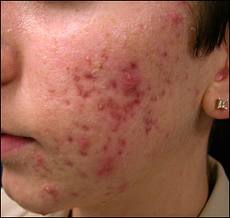 Acne is a common skin disease that affects the areas containing the largest oil glands. It occurs when the oil-secreting glands in the skin are clogged and become inflamed or infected.
Acne is a common skin disease that affects the areas containing the largest oil glands. It occurs when the oil-secreting glands in the skin are clogged and become inflamed or infected.
According to Ayurveda, Acne is believed to be from aggravation of dosha’s and it happens due to the excessive intake of alcohol, tea, coffee, spicy, oily and fried foods. Stress, tension, pollution and chemicals are also among the major causes for skin problems like acne, boils, pimples and rashes. The disease is seen mostly in teenagers and it is estimated that approximately 90% teenagers get acne.
Home Remedies for Acne
- A paste made from one teaspoon each of sandalwood powder and turmeric mixed with milk, is very good.
- A paste of nutmeg and water is also beneficial.
- Half a cup of Aloe Vera pulp can be taken internally (Do not take internally if pregnant) or applied externally to the skin. Dosage: Twice a day.
- Before going to bed, wash the face thoroughly and then apply a paste of 1 tsp. coriander juice mixed with a pinch of turmeric powder.
- Crushed basil leaves are effective measure. Apply on affected part and leave it for 30 mins. Wash and dry with soft towel.
- Apply paste made by mixing together a half teaspoon of ground cinnamon with one tablespoon of honey.. Apply the paste to the areas that need it before you go to bed and then rinse off the dried paste in the mornings. Honey has antibacterial properties and may also speed up healing.
- A paste of fresh fenugreek leaves, applied and washed off with warm water before going to bed prevents acnes.
- Application of cucumber juice mixed with juices of carrot or lettuce is an excellent home remedy for acnes
- Eating food rich in beta carotene, such as carrots, pumpkin and other yellow-orange fruits and vegetables.
- Drink around 2 litres or 12 glasses of water. This will will help body’s self cleansing, self-purifying systems to be in perfect working condition and protect skin from toxicity.
- Almond oil is good acne home remedy for dryness & inflammation of the skin.
- Keep away oily, fried food items and sweets.
AYURVEDIC COOKING
September 18, 2012 by admin
Filed under Featured, Tips for Ayurveda
In Ayurveda balance of diet is mandatory to ensure the dosha’s are in balance. The spices used commonly in the kitchen and their significance to mankind. Spices improve the digestion. In indian household the art of cooking has been handed over from grand mother’s to young ones. It is a joint effert by all women in general to prepare dishes.
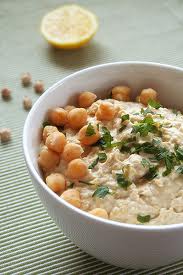 Ayurveda provides detailed instructions of daily regimen, seasonal regimen, food, sleep so that health can be optimized and illness healed. Ayurveda is grounded in metaphysics of the five elements, earth (prithvi), water (jal), fire (agni), air (vayu) and ether or space (akash). Ayurveda stresses a balance of three elemental energies or dosha’s: vata, pitta and kapha.
Ayurveda provides detailed instructions of daily regimen, seasonal regimen, food, sleep so that health can be optimized and illness healed. Ayurveda is grounded in metaphysics of the five elements, earth (prithvi), water (jal), fire (agni), air (vayu) and ether or space (akash). Ayurveda stresses a balance of three elemental energies or dosha’s: vata, pitta and kapha.
Ayurveda notes that the cause of most physical illnesses is due to poor digestion; well digested foods mean nutrition is absorbed and fed to the body for health and immune strength. So let’s take a more grateful look at these ‘sacred crumbs’
Let’s take a look at the spices and the benefits.
1. Black Pepper ( Kalimirch)
Best for Dosha: Vayu and Kapha dosha (constitution) people
Best for Conditions: Burns up ama very well, colds, flu, cough, gargle for sore throat, fevers, colon cleanse, digests fat and obesity; metabolism, mucus, expectorant, sinus congestion, cold extremities, raises agni, epileptic seizures, with honey, clears Kapha from the system in the morning. External-inflammations, urticaria, erysipelas.
2. Cumin (Jeera)
Best for Dosha: Vayu, Pitta and Kapha dosha (constitution) people
Best for Conditions: digests bread,, gas, digestion, abdominal pain, distention, for overeating and eating heavy foods.
3. Cardamon ( Elaichi)
Best for Dosha: Vayu, Pitta and Kapha dosha (constitution) people
Best for Conditions: Absorption of nutrients, asthma, bronchitis, colds, cough, excellent for stomach complaints, hoarseness, indigestion, loss of taste, helps the spleen and pancreas, reduces Kapha in lungs and stomach, stimulates the mind, with milk it reduces mucus formation, detoxifies caffeine in coffee, nervous problems, digestion, vomiting, headache, belching, acid indigestion, nausea, expels Vayu in colon and digests foods in colon, convalescing from diarrhea, biliousness, respiratory disorders, involuntary urination.
4. Coriander ( dhania)
Best for Dosha: Vayu, Pitta and Kapha dosha (constitution) people
Best for Conditions: Griping, flatulent colic, rheumatism, neuralgia, indigestion, vomiting, intestinal disorders, removes excess Kapha, eyewash, conjunctivitis, relieves internal heat and thirst, skin/rash problems, urogenital system (burning urethra, cystitis, infections, etc.), sore throat, allergies, hay fever, for all Pitta disorders, burning, juice for allergies, hay fever, and skin rashes (and externally as well); antidotes hot pungent foods, bleeding hemorrhoids. Used to balance very hot foods and spices (eg, chillies).
5. Fennel (Sounf)
Best for Dosha: Vayu, Pitta and Kapha dosha (constitution) people
Best for Conditions: Abdominal pain (gas or indigestion), menstrual cramps, hernia, diarrhea, colic, vomiting, morning sickness, nausea, anorexia, cough, dry cough, promotes semen, increases vision, raises agni, difficult or burning urination, digestion-children and elderly; promotes menstruation, nursing mothers-increases breast milk flow.
6. Fenugreek ( Methi)
Best for Dosha: Vayu & Kapha dosha (constitution) people
Best for Conditions: Longevity, nerves, allergies, arthritis, skin, rejuvenation, diabetes, allergies, bronchitis, flu, chronic cough, dysentery, dyspepsia, convalescence, edema, toothache, sciatica, neurasthenia, counters cold (i.e., extremities, abdominal pain, indigestion, respiratory and reproductive systems, hair growth, promotes breast milk flow, liver hypo-function, seminal debility, debility, outdoor winter work).
Precaution: Do not use large quantities when pregnant.
7. Turmeric (Haldi)
Best for Dosha: Kapha/ good for all doshas in moderation
Best for Condition: Amenorrhea, anemia, arthritis, blood purifier, blood tissue formation, circulation, cooking spice, cough, diabetes, worms, jaundice, eye problems, fevers, gas, hemorrhoids, edema, indigestion, ligament stretching, metabolism regulator; mucus relief, and hysteria (from inhaling fumes); pharyngitis, protein digesting, skin disorders, abscess, urinary diseases, wound and bruise healer; a natural antibiotic that also improves intestinal flora; inflammatory bowel syndrome (e.g., ulcerative colitis), Chron’s Disease, chronic hepatitis, chronic bronchial asthma, psoriasis, all inflammatory conditions.

Spiritual Uses: Gives one the Divine Goddess’s energy and prosperity; Chakra and subtle body cleanser; limbers for Yoga asana practice.
So bring the family into the kitchen and share the magic of cooking, sprinkle a little more love in your life; save money, enhance health, and discover just how sacred the cooking experience can be!
TIPS FOR LONG BLACK HAIR
September 18, 2012 by admin
Filed under Tips for Ayurveda
 Since hair is protein (keratin), hence a diet that is too low in protein will lead to thinning of hair or retardation in the growth cycle. If you eat a protein-rich diet, it will often result in improved hair growth.
Since hair is protein (keratin), hence a diet that is too low in protein will lead to thinning of hair or retardation in the growth cycle. If you eat a protein-rich diet, it will often result in improved hair growth.
Some nutrition experts propose the consumption of calves liver, fish oil or protein, eggs, yeast, wheat and a daily dose of two tablespoons of granulated lecithin to increase hair length, hair growth, strength, and health of hairs.
Other high-quality food sources for protein include beans and yogurt. Soya bean protein has also been found to be helpful in increasing hair growth. In addition to making changes in the way of life. Take the following supplements every day to increase hair growth:
List of Vitamins that are useful to fast growth of hair.
- Vitamin B-complex one of the major B-vitamins (like B-12, B-6).
- Vitamin B-6 and Folic Acid.
- Vitamin C with bioflavonoid in citric fruits.
- Vitamin E found in fish and other sea foods.
Apart from vitamins – iron, calcium, Magnesium, sulphur, zinc, silica etc.
Mostly these irons and vitamins are found in fruits, dry fruits and green vegetables and oil like olive oil, coconut oil, butter etc. However, try to avoid excessive sugar in routine diet which harms your skin and health. Stress and pressure can play important role in hair loss. Improper sleep and bad food habits are also the cause of it.
Here are some natural tips of Hair care as given below.
- Massage your scalp using coconut oil, herbal natural oil, or almond oil, for at least 20 to 30 minutes on a proper manner. Massaging conditions the hair and prevents drying of hair. A good head massage help to increase blood circulation to scalp skin and aid hair growth. Head massage also reduces stress, tension headaches and induces good sleep.
- If you are using coconut oil then if possible, boil it for 2 minutes, then add vitamin E capsule in it, and then massage your scalp slowly and gently.
- Our body produces natural oil which is secreted through oil glands of skin and scalp. This oil keeps our hair strands conditioned. Hence do not use harsh shampoos or soaps which strip off natural oil of scalp. Always use mild shampoo to wash hair..Do not use low quality shampoos, conditioners or hair gel because they will damage your hair or may make them brittle and rough.
- Coconut is best nutrition for hair; try to include coconut in your regular diet like in dals, sabjis, and vegetables etc. Coconut milk is also good for hair growth.
- Make a paste of methi, lemon, and curd then massage that paste on the scalp. After 15 to 20 minutes shampoo your hair gently. It will definitely give a shine to your hair and is helpful for the hair growth. Do this once in 15 days regularly.
- Wash your hair with tea decoction. That increases the shine and length of hair. Wash your hair once in three days only. Repeated hair wash leads to dry hair and split ends.
- Never, ever scratch the clumps with your fingernails. It will cause wound on your scalp. It will also cause infection, as there are harmful bacteria often present underneath the nails. If you have dandruff problem then wash your hair with lemon or curd.
- Drink plenty of water (2 liters or 12 glasses per day). Water flushes out toxins and increases moistness of skin and hair. This prevents splitting of hair.
- Brush your hair from root to tips before taking head bath.
- Wear a swimming cap to prevent hair damage due to chlorine.
- Avoid tying hair tightly with hair bands. This leads to baldness.
- Eat a healthy Balanced diet. Include plenty of green vegetables, fresh fruits, minor millets, milk and milk products. Vegetables and fruits provide antioxidants and minerals which are necessary to keep the body healthy. Amla (amalaki or Indian gooseberry or emblica officinalis), is considered as a fruit which help in hair growth. Include banana in your diet as banana contains plenty of calcium which is a vital nutrient required for hair growth. Healthy diet prevents hair loss and improves quality and quantity of hair.
- Exercise regularly. This helps to increase blood circulation and keep our whole body healthy and rejuvenated. A brisk walk for 30 minutes is advisable for all ages.
Follow these tips for maintaining hair. This hair care system helps the hair tremendously and you will have many admirers your way. There are many hair care systems including the Indian Ayurvedic systems, which has a number of prescribed methods that have proven beneficial since centuries as Ayurveda is a very old medicinal system from India.
TIPS FOR INCREASING HEIGHT
September 18, 2012 by admin
Filed under Tips for Ayurveda
It is a dream of every individual to be tall and attractive. Exercise is necessary for increasing your height. When you exercise, your body releases human growth hormone, into your body. These hormones activate your bones, muscles, and tissue to increase in size. The most of your height comes from your legs and spine.
When we are young , in our teens there is more scope for increasing height. When young the bones are mostly cartilage and develop as solid bones as we age. Furthermore, the cartilage plates are situated at the end of the bones, which are responsible for the growth of the body. Proper nutrition and adequate exercise is essential for proper growth during teenage.
Besides, enough calcium and proteins along with calories are essential for physical growth. Moreover, proteins provide amino acids, which are needed to build muscles. And, proper growth of muscles is necessary to increase height during puberty. In addition, adequate amount of calories acts as a fuel for our daily activities. Also, calories help to build muscles. In addition, calcium is also essential to increase height during puberty, since calcium not only strengthen the bones but also, helps in their growth. Additionally, lack of essential nutrients may sabotage the body’s efforts to grow taller.
Sleep is an essential factor for increasing height as it is generally said that sleep aids process of growth. Adequate sleep is required.
To make your vision come true here are a few tips to gain healthy nutrition and increase height.
- Eat well balanced diet which contains proteins, calcium, vitamins, minerals and zinc. Include milk and green vegetables in your meals, it improves height.
- It is important to eat at regular intervals.. Never skip a meal.
- It is essential to keep digestive system healthy, so chew well while eating.
- Cycling and swimming are most useful exercises for increasing height. It also enhances the overall fitness level of a person. You can also do exercises like skipping and spot jumping. Tennis and basket ball will help you in increasing a good height. For playing these games jumps require, so play it regularly.
- Increase intake of green leafy vegetables, and fresh fruits.
- Sleep at least 8 hours per day. Sleep is necessary for getting a good height.
- Avoid alcohol & smoke. Preferably avoid soda drinks, fried – oily items, sweets.
- Stretching exercises are one of the most useful and natural ways to increase height. It focuses on the parts of your body that you want to grow.
- Use more of wheat based products than rice based.
 Various postures of yoga are specifically used to grow taller. In addition, yoga postures also enhance the body’s ability to absorb nutrition, which is very important to increase height. Tadasana is one of the famous asana of Yoga for increasing height. Do this asana regularly. Other asana(s) of yoga is also helpful such as Surya namashkar, Sukahasana, Bhujangasana etc.
Various postures of yoga are specifically used to grow taller. In addition, yoga postures also enhance the body’s ability to absorb nutrition, which is very important to increase height. Tadasana is one of the famous asana of Yoga for increasing height. Do this asana regularly. Other asana(s) of yoga is also helpful such as Surya namashkar, Sukahasana, Bhujangasana etc.
Steps for Tadasana:
- Stand straight and move your hands over your head.
- Join both the hands, in a way that your arms touch your ears.
- Balance your weight on your toes.
- Maintain the postures for 10-15 seconds.
- Return back in normal position.
HOW TO IMPROVE VISION
September 18, 2012 by admin
Filed under Tips for Ayurveda
The eyes are one of the most beautiful and precious of our senses. We can never get a pair as replacement. Eye is one of the most important body parts in human body. Eyes are responsible in act of vision in humans. With the aid of our eyes we are able to see the things around us and perform our daily activities with great ease. Any disruption in the functioning of eyes leads to great difficulty and discomforts. Many general precautions should also be taken, Ayurveda for instance suggests avoiding reading in inadequate lighting settings and, of course, avoiding watching TV for a long period of time.
Drishti dosha is the name for defective eyesight in ayurveda. This can be caused due to various factors such as nervous disability, diabetes, excessive smoking and alcohol intake. Age related defects can also lead to problems with eyesight.
.Ayurveda advises to take care of health while in a healthy state. As the famous proverb quotes,” Prevention is better than cure”. You can maintain perfect eyesight for most part of your life by following some simple remedies.
- Every morning after waking up, fill your mouth with water, close the eyes and sprinkle water on them about 10-15 times. Be sure, as Ayurveda advises, to wake up before sunrise. Do not use hot water to wash the eyes.
- Do not wash the eyes or face when the body is sweating, especially after hard physical exercise or after being exposed to heat and sun.
- Carrots have good quantity of vitamin A which proves to be one of the useful natural treatment for enhancing your eyesight.
- Consuming good amount of apple and grapes helps in improving your eyesight.. Cucumber juice does wonders for your eyesight as it tries to improve it immensely.
- Staying up late in the night and sleeping after sunrise is harmful for the eyes. In case of staying up late, drink a cup of water after each hour or half hour.
- Protect your eyes from dust, smoke, strong sunlight and strong wind. Avoid staying long in such conditions. In case you have to stay, blink often and massage the closed eyes gently with your palms.
- Try to maintain regular and clean bowel movements. Constipation weakens the eyesight. In addition; too much anxiety, mental stress, grief, anger and worry are harmful for the eyes.
- Amla a very common herb to improve the eye sight.
- Addition of spinach in your diet is beneficial. It purifies your blood, increases the hemoglobin and improves your eyesight.
- Increase fresh fruits and vegetables in your diet.
- Vitamin A is directly responsible for the strength and power of the eyes. Hence, foods that are rich in vitamin A must be taken.
- Drink four to five liters of water daily.
- Yoga and pranayama are great exercises to improve eyesight.
Regular eye exercise maintains perfect eyesight. A few simple exercises:
- Move the eyeball – right and left; upwards and downwards and rotating it in the clockwise and anti-clockwise directions.
- Place a object in front of your nose . Take it forward and backward repeatedly. Keep observing the object to and fro with both the eyes.
 By using palming which can be stated as a revised version of the thousand-year-old yoga tradition known was Hatha Yoga. It relieves strain and stress from your mind and eyes which needs the required break. For this you have to warm your hands by rubbing them together vigorously. Once it’s warm cover the eye without touching the eyelids. This relaxes the nerves and helps in blood circulation.
By using palming which can be stated as a revised version of the thousand-year-old yoga tradition known was Hatha Yoga. It relieves strain and stress from your mind and eyes which needs the required break. For this you have to warm your hands by rubbing them together vigorously. Once it’s warm cover the eye without touching the eyelids. This relaxes the nerves and helps in blood circulation.







